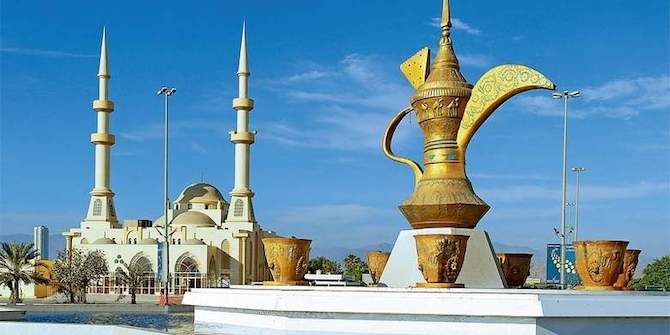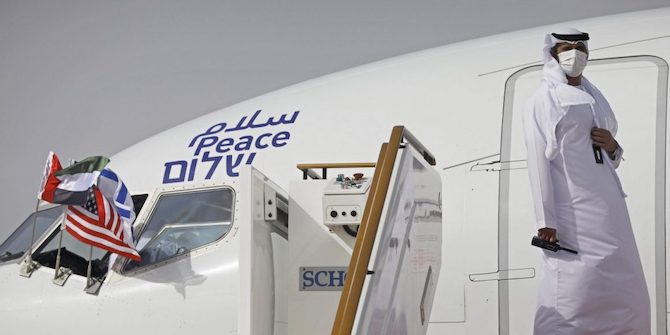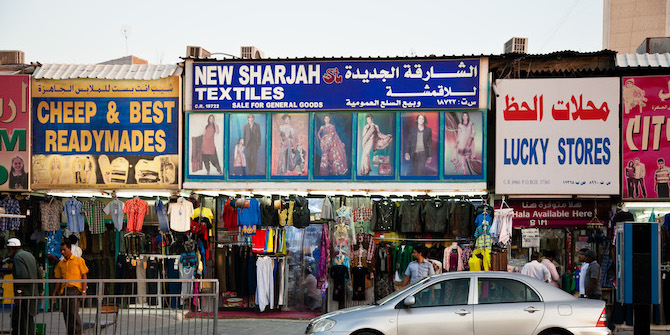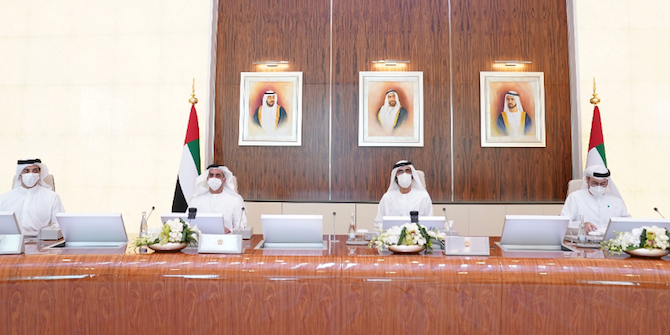by Matthew MacLean

‘Now I feel like I live in a real country,’ a friend told me after a trip through the mountains of Ras al-Khaimah and Fujairah. Her comment was hardly unique; expatriates and Emiratis alike often perceive the north as more ‘real’ and ‘authentic’ than the UAE’s major cities of Dubai and Abu Dhabi. Broadly speaking, the northern emirates – Ras al-Khaimah, Fujairah, Umm al-Quwain and Ajman – are smaller, more rural, and less internationally celebrated than Abu Dhabi, Dubai, and Sharjah. Rana AlMutawa has examined how narratives of unreality and inauthenticity have shaped perceptions of Dubai, and the present author has analysed the role of the built environment in perceptions of authenticity in the northern emirates. How do heritage practices shape this contrast in perception? Here I examine heritage and identity construction through the lens of various spatial scales – national, local, and hyperlocal – and through an analysis of public and private heritage practices and narratives in the northern UAE.
First, the quiet, small, and somewhat old-fashioned museums in the north offer a stark contrast to the massive state-sponsored heritage festivals in Dubai and Abu Dhabi. The national museums of Ajman, Umm al-Quwain (UAQ), Ras al-Khaimah (RAK) and Fujairah were founded in the 1980s and 1990s and have changed little since the day they opened. Because of the comparative lack of wealth in the northern emirates, these museums are underfunded and unrenovated (a recent proposed revitalisation of the National Museum of Ras al-Khaimah failed for this reason). But it is precisely because of their smaller scale and humble collections that they succeed in crafting heritage narratives for their respective emirates that visitors perceive as ‘charming’ and ‘authentic.’
More importantly, the northern museums narrate a comparatively seamless connection between pre-oil lifeworlds and the present, whereas Abu Dhabi’s annual Qasr al-Hosn and Sheikh Zayed Heritage Festivals strictly define heritage as those lifestyles and architecture that existed before oil-driven modernisation. In other words, in the less-developed emirates, the experience of modernisation is emphasised more than in Sharjah or Abu Dhabi. The Ajman Museum, for example, includes an exhibit on Ajman’s first radio station. The Umm al-Quwain Museum contains displays of the emirate’s first passport, driver’s license, a telephone, stamps and gifts from foreign leaders. When combined with areesh huts, date harvesting tools and pearl fishing exhibits, the effect is a merger of the past with recognisable artefacts of present daily life.
Located in a fort once occupied by the ruling family, far from the madding crowds of modern life, the museum is above all quiet – a noticeable contrast with the bustling urban soundscapes, blaring megaphone-amplified music and announcements, and hordes of tourists that characterise the larger festivals of Abu Dhabi and Dubai. But the UAQ Museum nevertheless makes a direct connection to the larger nation. Photographs of previous UAQ rulers with Sheikh Zayed and a legitimising narrative of how Sheikh Ahmad bin Rashid al-Mualla (the grandfather of the current ruler) came to power in 1928 link the local UAQ identity to the national UAE context.
Beyond state-sponsored heritage initiatives, however, the north is known for the extensive number of private museums and heritage-related clubs characterised by hyper-local, even personalised identity narratives. These are especially numerous in Ras al-Khaimah (RAK), the UAE’s northernmost emirate. RAK’s history is deeply shaped by its geography. Unlike other emirates, it sits at the intersection of four environments – deserts, coastline, mountains and date palm oases. These gave rise to local populations with a variety of means of earning a living in the pre-oil era, and a comparatively high degree of political contestation. In addition to the National Museum of RAK, these lifeworlds are commemorated in a series of museums undertaken at the initiative of private citizens.
Private museums reflect their founders’ interests and quirks. But like the state-sponsored National Museums, they reveal a comparatively seamless connection between the past and present that is read by foreigners and other Emiratis as ‘authentic.’ The Ahmed Bin Majid Association in Ma’aridh contains a huge collection of pre-oil maritime artefacts, photographs of all the forts and watchtowers in Ras al-Khaimah emirate, and a collection of photographs of modern (1980s/90s) Ras al-Khaimah city. Much of the collection – especially the pre-modern ‘heritage’ items – is unlabelled; the assumption is either that someone will be present to explain its significance or that no explanation is needed.
In Ghalilah, one of the UAE’s northernmost towns, Saeed Ali Lahha al-Shehhi built the Zayed Heritage Village, a combination of his personal mementos and artefacts, library, heritage collection and nods to national identity – including, for example, a banner of the rulers of all the emirates throughout the UAE’s history and photographs of al-Shehhi with Mohammed bin Zayed. But what ties it together are the sketches of Ghalilah and Sha’am (two small towns along the UAE’s northern coast) from the mid-twentieth century, an unspoken connection from the local to the national. Again, most items are not labelled – they speak through the curator’s personal tours of his collection.
Both state-sponsored and private museums in the north are characterised by the move from the hyperlocal and personal to the national. In doing so they link their respective locales to the wider story of the UAE, expressed as the person of Sheikh Zayed. Their narratives overtly bridge the transition from the pre-oil era through twentieth century modernisation, creating a link in time as well as space. This is read by many as authenticity and as ‘the real UAE’ – but we must note that there is nothing particularly ‘inauthentic’ about the extremely popular state-sponsored festivals and large-scale museums of Dubai, Sharjah and especially Abu Dhabi. The difference is in the effacing of the local and the emphasis on a common national identity.
This is part of a series emerging from a workshop on ‘Heritage and National Identity Construction in the Gulf’ held at LSE on 5–6 December 2019. Read the introduction here, and see the other pieces below.
In this series:
- Introduction by Courtney Freer
- Souvenir Sovereignty in Qatar by Suzi Mirgani
- Examining Kuwait National Museum by Sundus Alrashid
- Urban Planning and its Legacy in Kuwait by Alexandra Gomes
- Museums as Political Institutions of National Identity Reproduction: Are Gulf States an Exception? by İdil Akıncı
- The New Populist Nationalism in Saudi Arabia: Imagined Utopia by Royal Decree by Madawi Al-Rasheed
- Heritage and Sectarianism in Bahrain by Thomas Fibiger
- Dubai Expo 2020 and Ancient Mercantile Heritage by Robert Mogielnicki
- Managing UNESCO World Heritage Sites in Saudi Arabia: Contribution and Future Directions by Abdulelah Al-Tokhais
- Finding Mariam: The Invisible Woman in Kuwait’s National Heritage Mythology by Alanoud Al-Sharekh
- Cultural Attendance: Attracting the Crowds to Museums in Saudi Arabia by Maha al-Senan
- Religion and Heritage in the Gulf: Significant in its Absence? by Courtney Freer
- Historical Archaeology in the Gulf by Robert Carter
- Militarised Nationalism in the Gulf Monarchies: Crafting the Heritage of Tomorrow by Eleonora Ardemagni
- Displaying the Nation in Museum Exhibitions in Qatar by Alexandra Bounia
- Implicit and Explicit Cultural Policies in Qatar: Contemporary Art Production and Censorship by Serena Iervolino
- The UAE State ‘Rebirthing’ of Motherhood: Who is birthing who? by Rima Sabban







Thanks Mathew for let us know about the UAE heritage, I learned new things as a UAE resident who has much interest in history but especially UAE heritage.
The agreement to bring Emirati crude oil by tanker to a pipeline in the Red Sea port of Eilat was signed after Israel normalised ties with the Gulf Arab nation late last year.